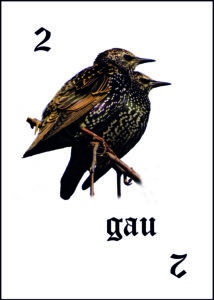Auspice Cards
Something in human nature loves a pack of cards. Whether it’s a fresh deck of poker-size Bees, a complete set of Astronaut cards from the 1960s, Mexican Loteria cards, The Waite Tarot, Magic: The Gathering, or Artist Trading Cards, they are both uniform and individual, pedestrian and mysterious, three-dimensional objects that often convey arcane symbolism.
None perhaps more so than the legendary Auspice Cards.
The earliest reference anyone has found to Auspice Cards comes from the “Parliament of Fowls” by Geoffrey Chaucer, published in the last decade of the fourteenth century, shortly after the first playing cards made their way to Spain from Mamlūk Egypt. Chaucer’s poem suggests that Auspice Cards are even older than the Egyptian cards, and possibly older than the ninth century cards used in Tang dynasty China:
And with the cries, when their song was done,
That such fowls make as they depart,
I woke, and ancient cards did read
In search of succor for my heart.
Older than Egypt or Cathay
Goshawk, Starling, Chaffinch gay
If keys to dreams you can provide
Henceforth I sleep with you beside.1Translated by A. S. Kline © Copyright 2007, All Rights Reserved. https://www.poetryintranslation.com/PITBR/English/Fowls.php.
The Cards
The cards had three suits: Goshawks, Starlings, and Chaffinches. Numbers ran from zero to nine for Goshawks and Chaffinches, but only zero to five for Starlings.2The zero was not used in Europe until around 1200 AD, which conflicts with the claim that the auspice cards predate Egyptian cards. Also, the birds used on the cards are all native to Europe. Each “suit” had its own design for the backs of its cards.
The following is an artist’s reconstruction of the only fully described auspice card we know of, a Two of Starlings.3The photo at the center of this image is by Kathy Büscher (https://pixabay.com/users/kathy_buscher-5562794/).

Note the number in the upper left and lower right corners (“corner indices”). This innovation was only introduced to standard playing cards in the 1860s and shows that the cards were at some point designed to be held, several at a time, in one hand.
“Gau” means “joy” in an old, poetic form of Latin. Clearly this refers to the augury “one for sorrow, two for joy, three for a girl, four for a boy,” etc., so the cards must also have been used for divination.4The word “augury” comes from “divination from the flight of birds” (https://www.etymonline.com/search?q=augury). We don’t know if a card being reversed changes its meaning, as with the tarot.
The Book of Auspices
One such divination ritual is described in journals of John Dee, the court astrologer to Queen Elizabeth I (b. 1527). The ritual begins with the seeker shuffling the pack or packs. In some versions all three packs are shuffled together, while in others the packs are shuffled separately, by suit.
If the packs are shuffled separately, they are placed side by side, Goshawks on the left, Starlings in the center, Chaffinches on the right. The top card from each pack is turned face up.
If the packs are shuffled together, the seeker deals the cards to a discard pile, face down, until the design on the back indicates that the suit is Goshawks. The Goshawk card is then dealt, face-up, to the left. The seeker then discards until a Starling back is revealed. The Starling card is dealt, face-up, to the center. The seeker continues to discard until a Chaffinch back is revealed. The Chaffinch card is dealt face-up, to the right.
A three-digit number is thus obtained. The adept would then look up the number in the Book of Auspices (which the seeker was not allowed to read) to learn how favorable the auspices are for the selected number.
No copy of The Book of Auspices is known to still exist anywhere. Its contents were cryptic, to say the least, for example:
310 Release. Highly auspicious.
404 Sleeplessness. Poor prospects.
555 Chaos averted. Favorable.
Supposedly some similar comment was given for each of the 1000 possible number combinations.
One of the last holdouts for Auspice Card readings (the “lucky” ones such as 444) was in picking three-digit numbers to bet on in the numbers racket. With the crackdown on organized crime in 1929, Auspice Cards seemed to disappear.
Hoax?
Many commentators, prominent among them Joseph Campbell, maintain that Auspice Cards are a hoax.5Joseph Campbell, The Masks of God: Oriental Mythology (New York: Viking Press, 1959). However, there doesn’t seem to be any rational reason for perpetrating it or any benefit to be had from such a deception.
Created 7 Mar 2023
